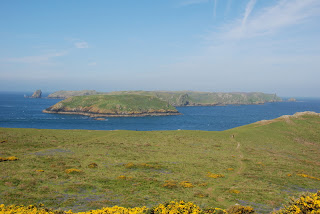

A lazy start was followed by a walk along the valley, this time beyond Llanychaer. This section had been recommended to us by the allotment gardener. She was quite correct, it was even prettier than the lower section. The wide path follows the river, sometimes close through woodland and other times on the edge of woodland with meadowland between the path and the river. The sound of the river is ever present and mini waterfalls and natural weirs add to its attractiveness. Meeting the river at Cilrhedyn Bridge we turned around and walked back on the same route. The weather was perfect for walking – sunny and warm with hardly any breeze.
Just at the end of the walk we met a family who were doing a similar walk and thoroughly enjoying it. Their young daughters had just been for a swim in the river, much to the surprise of their parents and us – it must have been freezing! These were the only people that we met on the 6 km walk.
As we approached the road close to campsite we met, for the third time, the barking but friendly dog at Ty-Hen. The owner had told us that the dog shouldn't run, a bit of a problem when a footpath runs through the property and the dog can wander freely. Apparently the dog had bone cancer in its leg and instead of the normal treatment of amputation, it had a titanium implant to replace the bone in its leg. It is only the 17th time this procedure had been done in the UK and she is still receiving chemotherapy. A much loved and very expensive bionic dog! The operation seemed to be an amazing success and we would never have known that she had a titanium leg.
Photos: Horses in the Gwaun Valley; Mini waterfall on the Gwaun river.
Just at the end of the walk we met a family who were doing a similar walk and thoroughly enjoying it. Their young daughters had just been for a swim in the river, much to the surprise of their parents and us – it must have been freezing! These were the only people that we met on the 6 km walk.
As we approached the road close to campsite we met, for the third time, the barking but friendly dog at Ty-Hen. The owner had told us that the dog shouldn't run, a bit of a problem when a footpath runs through the property and the dog can wander freely. Apparently the dog had bone cancer in its leg and instead of the normal treatment of amputation, it had a titanium implant to replace the bone in its leg. It is only the 17th time this procedure had been done in the UK and she is still receiving chemotherapy. A much loved and very expensive bionic dog! The operation seemed to be an amazing success and we would never have known that she had a titanium leg.
Photos: Horses in the Gwaun Valley; Mini waterfall on the Gwaun river.















































